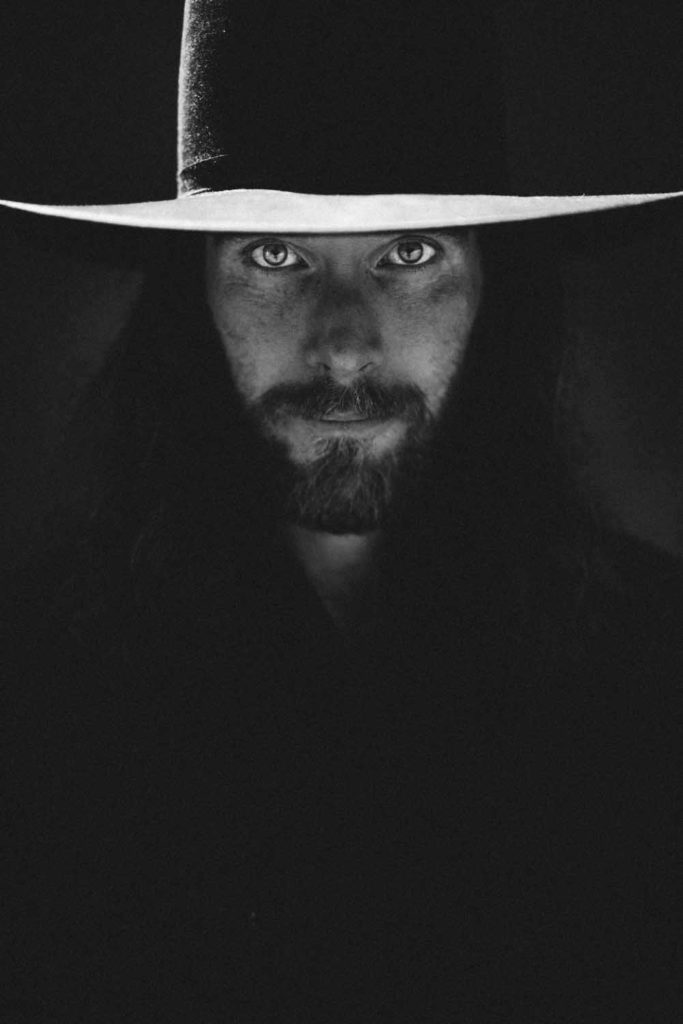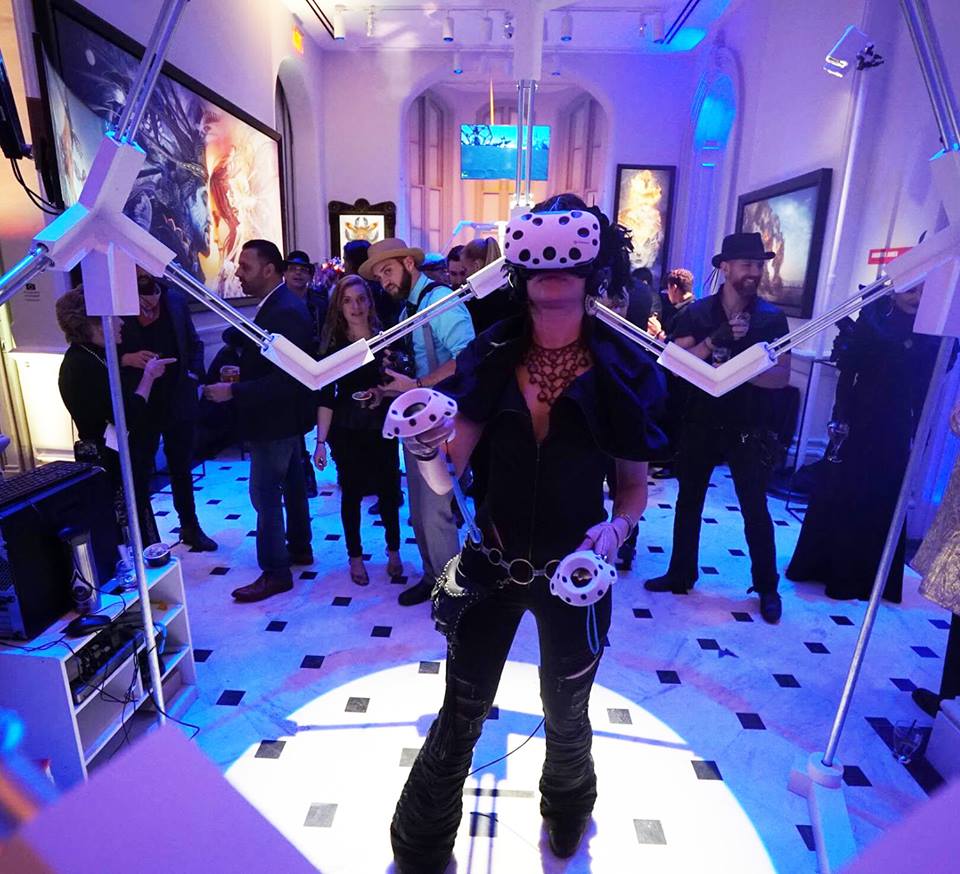
Strolling across the property where artist Android Jones lives, it seems fitting that a man whose art is often experienced projected against domes would live in a place where half circles abound. We pass a large, disassembled geodesic dome on our way to visit his chickens, which also happen to be protected from the local mountain lions, hawks and bears by a dome of wire. Never one to be outdone, nature cradles the property in domes of its own: the softly rolling hills just outside of Lyons. Jones grew up here, himself a third generation Boulderite, his daughter and unborn child the fourth.
The scene is a feast for the eyes, like walking into an early Cézanne painting, from the organic apple orchard with hundred-year-old trees to the classic barn Jones’ father built — then rebuilt after it caught fire in 2008 — that acts as the artist’s studio.
Inside the barn is a scene that’s Tim Burton meets Tim Berners Lee; a cluster of computers mine crypto-currency 24/7, and doo-dads and whatsits on every available surface beg for a few moments of your undivided attention, which, if given to each item, would amount to approximately one normal human life span spent scoping out neat-o stuff. A dry erase board near a multi-screen virtual reality set-up seems to attempt to sort out the mathematics of creativity.
Every thing in Jones’ physical world seems to sit at the intersection of nature and technology, much like his art. Trained in the classic styles of art-making, Jones slowly moved toward digital execution, now famous for his virtually rendered pieces of incredible detail that depict humans and the natural world.

Jones — Andrew to his family — is part of a history of visionary artists who hail from Boulder (Amanda Sage and the late Robert Venosa), though the term “visionary” art feels a little pretentious to Jones. More bluntly, what Jones creates is psychedelic art, often while on hallucinatory drugs, in an attempt to bring that vibrant parallel world back to the rest of us. His art is a gentle reminder of our role in the grand scheme of things, a New Age gospel of sorts, silently preaching a message of global unity, ego-death and self-actualization. In terms of messaging, his work is reminiscent of that of Alex Gray — made famous by album covers for Nirvana, Tool and the Beastie Boys — but distinct in style.
His ever-evolving Samskara project has been showing periodically at Fiske Planetarium since 2015, whisking audiences through a subjective story about creation, life, death and rebirth, all based on the teachings of ancient Hindu scriptures known as the Vedas.
About a year and a half ago, Smithsonian American Art Museum approached Jones about featuring some of his pieces in large-scale in the Renwick Gallery, along with a brand new version of his virtual reality project, MicrodoseVR. Relabeled Deep Playa for the Renwick show, Jones’ VR experience lets visitors take a walk through a digital Burning Man, that magical adult playground that pops up in the Nevada desert each September. Patrons suit up at one of two VR pods set up in the gallery and use a joystick to fly through the desert toward massive sculptures, radiant fractals exploding into the field of vision at every turn.
The exhibit is called No Spectators after a central tenet of the Burning Man philosophy: By blurring the line between audience and performer, everyone is someone at Burning Man. It’s a tenet people carry back into the “Default World,” back to their normal lives outside of Black Rock City. Don’t just watch, take action.
Burning Man is an integral part of who Jones is as an artist and individual. He got introduced to the scene at the turn of the century while working as an intern at Industrial Light and Magic in San Francisco.

“One of the artists that I was sharpening pencils for was a burner,” Jones says. “I was probably 20, looking for likeminded people, community, kindred spirits, and I saw these photos of the playa [at Burning Man]… there are a lot of beautiful places and temples in the world but I had never seen anything of that magnitude and so many people that were actively participating in it. It stuck with me.”
In 2003 he went, by himself, with no idea what he’d find. Turns out he found what he was meant to do as an artist, and he’s been going back to the pop-up art paradise every year since.
“I think what makes it special is it’s got something for everybody,” Jones says. “If you want to go there and go full hedon (sic), there’s orgy tents and all the drugs you’ll ever need. If you want to go there and meditate and have some spiritual awakening; if you want to go there and dance or meet somebody; if you wanna create art or look at art; if you just wanna be introduced to things you haven’t seen before; if you wanna help out and work medical; there are as many reasons to go to Burning Man as people who go.”
It took Jones a while to turn the ship, though. He spent some time working for Nintendo in Austin, Texas, then moved back to San Francisco and made art for film and games.
“At the time all my art was pretty much commercial because it was the best way to pay back art school and pretty well respected to work in that field, but all the personal art I was making, the fine art, the more experimental kind of psychedelic art, was being done in a vacuum in my studio,” he says. “I was a closet psychedelic artist. It wasn’t something that was thought of highly by my peers.”
But things changed when psychedelic artist and Boulder-native Robert Venosa came to San Francisco and invited Jones to a show.
“I went to this show and saw this visionary art. It took me a second to get it: So you guys do psychedelics, make art, and you’re celebrated for that, where I had been kind of demonized for that. So I decided to switch teams right then and there. This group of people was way more in line with my values and the things I believe in.”
Things like self-exploration and the importance of human connection, humanity’s relationship with the universe and a search for collective meaning and individual truth. Eventually the need to follow this path overtook Jones and he quit his day job to go look for himself.
Jones soon found himself on tour with his friend Lorin Ashton, better known as the sub-bass frequency shattering DJ Bassnectar. It was the first time he’d created visuals live on stage, using a tablet strapped across his chest like an electric guitar.
“It was pretty scary and I didn’t know what was going to happen,” Jones says. “You’re just out there and everything you’re doing is on a projector. It takes a while for people to understand. They thought I was making music at first. It takes about 30 minutes for anything I’m making to even kind of jump out of subjective chaos into something people can recognize. The first 30 minutes are pretty awkward. But there’s a turning point where the picture starts looking like a face. At that point I think I might have gotten a thumbs up from somebody in the front row and that’s all the confirmation I needed.”
Jones isn’t shy talking about LSD’s role in the creation of his art. It’s a part of what’s helped break down barriers for him to access deeper parts of his personality, allowing him to make the kind of art he feels serves a greater purpose, spreading that message of universal interconnectedness and service in honor of the universe that gave us all life.
Which in no way means Jones thinks you need to do psychedelic drugs to achieve world peace or whatever. But he’s tired of the stigma. The point is to filter out the noise, so to speak, that keeps us from hearing our inner voices and each other. Many people achieve this through meditation, whether that means sitting silently in lotus position or spinning in a long skirt in reverence to God or losing yourself completely while playing Bartok’s Violin Concert No. 2 or participating in an ego-killing Ayahuasca ceremony.
“Art is … the most accurate technology you can use to try to communicate [psychedelic experiences],” Jones says. “These medicines and substances offer you this window into this completely subjective world that feels like you are seeing objective things and there’s no way to bring that back to people. Art is the best way we have to do that. Some people go on a journey and take notes and bring that back later. I’m a very visceral person. My process is I make art in that state. It’s really about the things that come through in that moment. For me, I can sometimes connect to a higher aspect of myself, and get the distractions out of the way.”
On the Bill: No Spectators: The Art of Burning Man — featuring art by Android Jones. Smithsonian American Art Museum, Renwick Gallery, 1661 Pennsylvania Ave., Washington, D.C. Through Jan. 21, 2019.














